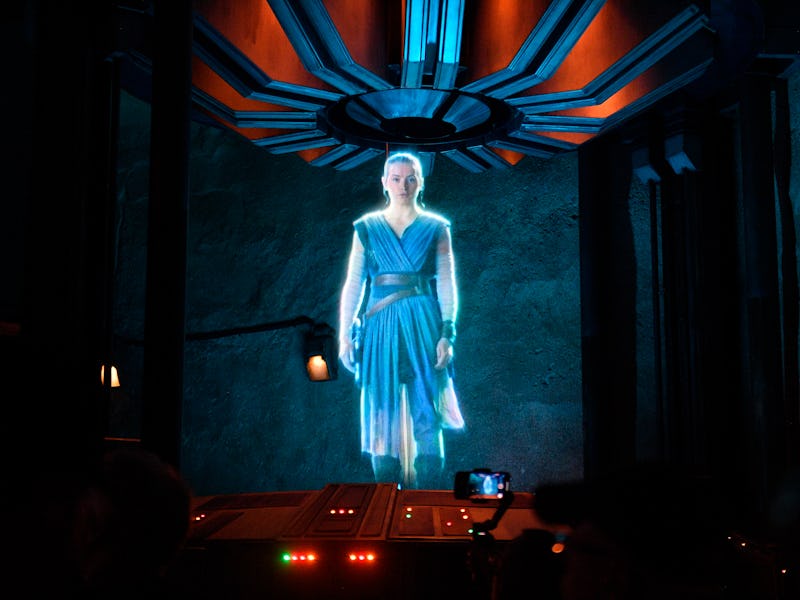Retro Star Wars-inspired tech gets a modern reboot
Immersive gaming could be getting a big boost.

When the fate of a galaxy far, far away was at risk, the embattled Princess Leia turned to a trusted technology to get her message out: holograms.
Invented by scientist Denis Gabor more than 70 years ago, holograms have since played a bigger role in science fiction than they have in our daily lives. That's because the technology required to produce these mind-bending projections has needed just too much computing power — and too much hardware — for holograms to be practical in everyday use.
But researchers at the Samsung Advanced Institute of Technology in South Korea are taking a new approach to holographic technology. The device they've come up with is both extremely small and runs off a single, custom processing chip in real-time.
Together, the researchers believe that these advances could finally bring holograms to your smartphone — and change gaming and communication forever.
At their base, holograms are nothing more than a (very) fancy light trick.
To generate a hologram, you need to diffract light in such a way that it tricks the brain into seeing a 3D projection of an object that's not really there. These projections can look so real that you might not even know the difference until you reach out to grab them and come up empty-handed.
Hungarian physicist Gabor discovered the trick in 1947 , but the leap from projecting a static, physical object to projecting video holograms didn't happen until 1990, when researchers at MIT Media Lab developed the first holographic video system.
Since that innovation, hologram technology has essentially stalled, argue the researchers behind this new paper, published Tuesday in the journal Nature Communications.
They say that while there have been some advances in creating static holograms, these are also "non-updatable or have a limited updating frequency." The inability of these technologies to innovate, they argue in the paper, causes "a fundamental limitation for generating dynamic holograms."
The researchers point to three major hurdles to overcome: pixel and viewing angle limits, limited space for manipulating outgoing light, and having enough computational power to compute real-time video.
Older hologram technology has had to trade off one solution for another — thin hologram screens today can only produce images in a narrow viewing range because they lack pixel density, for example.
This new design aims to overcome all these issues once.
See also: Full-color, low-cost 3D holograms are about to become real
Building a hologram projector — The researchers' secret sauce comes down to two key innovations: a slim backlight unit to steer the diffracting light, and a holographic video processor that fits on a single, smartphone-compatible chip.
While researchers hope to continue shrinking down their design to phone size, it's not quite there yet.
The way it works is this: Incoming light is generated by the hologram graphics card, and then passed through a sandwich of thin, optical layers that are less than half an inch thick.
The resulting device was able to produce a 4K resolution video with 30 times the viewing angle of existing hologram technology.
In their paper, the team tested the design by projecting a holographic video of a sea turtle swimming. The user was able to control the movement of the turtle with a computer keypad, and could watch as the foreground and background went in and out of focus depending on the turtle's movements.
"[This] proves the dynamic holographic image is updated in real-time using the holographic video processor," write the authors.
With their design, the hologram viewing angle was increased 30 times.
The graphics chip used in this prototype is already compatible with mobile devices like smartphones, so it wouldn't be difficult to implement this technology in a phone, the researchers say.
Ready for Christmas 2020?— Even though the computing system is confined to a single chip, the entire hologram system is still about four inches wide. That is not yet small enough to make a debut in next-gen smartphones or gaming consoles. But if the researchers continue to slim down and power up their tech, this kind of 4-D gaming and communication may be closer than we think.
The researchers themselves seem optimistic. They hope that their system, and its future iterations, will accelerate the adoption of holographic video for mobile devices. Who knows, maybe you'll be controlling your own holographic squadron of rebel fighters by Christmas 2030.
Abstract: Since its discovery almost 70 years ago, the hologram has been considered to reproduce the most realistic three dimensional images without visual side effects. Holographic video has been extensively researched for commercialization, since Benton et al. at MIT Media Lab developed the first holographic video systems in 1990. However, commercially available holographic video displays have not been introduced yet for several reasons: narrow viewing angle, bulky optics and heavy computing power. Here we present an interactive slim-panel holographic video display using a steering-backlight unit and a holographic video processor to solve the above issues. The steering-backlight unit enables to expand the viewing angle by 30 times and its diffractive waveguide architecture makes a slim display form-factor. The holographic video processor computes high quality holograms in real-time on a single-chip. We suggest that the slim-panel holographic display can provide realistic three-dimensional video in office and household environments.